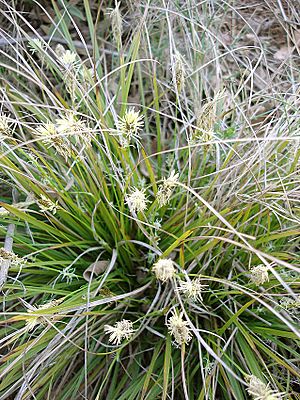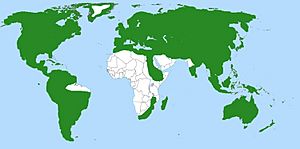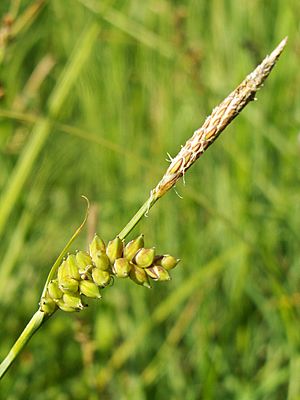Carex facts for kids
Quick facts for kids Carex |
|
|---|---|
 |
|
| Carex halleriana | |
| Scientific classification |
|
| Kingdom: | Plantae |
| Clade: | Tracheophytes |
| Clade: | Angiosperms |
| Clade: | Monocots |
| Clade: | Commelinids |
| Order: | Poales |
| Family: | Cyperaceae |
| Genus: | Carex L. |
| Type species | |
| Carex hirta |
|
| Diversity | |
| c. 1800 species | |
 |
|
| Global distribution of Carex (green) | |
Carex is a huge group of over 2,000 types of grass-like plants. They belong to the plant family called Cyperaceae. These plants are often known as sedges. While other plants in the Cyperaceae family are also called sedges, Carex plants are sometimes called true sedges. This group has the most species within its family. Studying Carex plants is called caricology.
Contents
What Are Carex Plants Like?
All Carex species are perennial plants. This means they live for more than two years. Some, like C. bebbii, can grow fruit in their first year. They might not live much longer than that.
Most Carex plants have rhizomes or stolons. These are like underground stems that help the plant spread. Some species grow in clumps, which is called caespitose growth. The main stem that holds the flowers is called a culm. It is usually straight and does not have branches. This stem often has a clear triangular shape.
The leaves of Carex plants have two main parts. There is a flat part called the blade, which sticks out from the stem. Then there is a sheath, which wraps around part of the stem. The blade is usually long and flat. Sometimes it can be folded or rolled up. The leaves have veins that run side-by-side. They also have a clear middle vein. Where the blade meets the stem, there is a small part called the ligule. Carex leaves can be green, red, or brown. They can be very thin and hair-like. Some are quite wide with sharp edges.
The flowers of Carex are small. They grow together in groups called spikes. These spikes then form a larger flower cluster called an inflorescence. A spike usually has many flowers. But some species can have as few as one flower. Almost all Carex species are monoecious. This means each plant has both male and female flowers. A few species are dioecious, meaning male and female flowers are on separate plants.
Sedges show different ways of arranging male and female flowers. Often, the lower spikes have only female flowers. The upper spikes have only male flowers. Some spikes in the middle might have female flowers at the bottom and male flowers at the top. In other species, all spikes look similar. They might have male flowers above and female flowers below (androgynous). Or they might have female flowers above and male flowers below (gynecandrous). Only a few species have flowers arranged in an irregular way.
A special part of the Carex plant is a bottle-shaped cover around each female flower. This cover is called the perigynium or utricle. It often has a "beak" that might be split at the end. The shape, veins, and hairs on this perigynium help tell different Carex species apart.
The fruit of Carex is a dry, single-seeded achene or nut. It grows inside the perigynium. The perigynium helps the fruit spread to new places.
Where Do Carex Plants Grow?
Carex species are found almost everywhere in the world. However, there are not many in hot, tropical lowlands. You also won't find many in sub-Saharan Africa. Most sedges grow in wetlands. These wet places include marshes, fens, bogs, and other peatlands. They also grow along pond and stream banks, in riparian zones (areas next to rivers), and even in ditches.
Carex plants are a very common group in arctic and alpine tundra areas. They also thrive in wetlands where the water is up to 50 centimeters (about 20 inches) deep.
How Are Carex Plants Classified?
The group Carex was first named by Carl Linnaeus in 1753. It is one of the largest groups of flowering plants. Scientists estimate there are between 1,100 and almost 2,000 species.
Carex plants have very active chromosome changes. Their chromosome numbers can range from 6 to 66. More than 100 species are known to have different chromosome numbers within the same species. There can be a difference of up to 10 chromosomes between groups of the same plant.
Carex has been divided into smaller groups called subgenera. One important way of classifying them was by Georg Kükenthal. He used four subgenera based on how male and female flowers were arranged. These were Carex, Vignea, Indocarex, and Primocarex. There has been much discussion about these groups. Some species have been moved between groups. Some scientists, like Kenneth Kent Mackenzie, preferred to divide the genus directly into sections instead of using subgenera.
Today, the genus is divided into about four subgenera. Some of these might not be "monophyletic." This means they might not all share a single common ancestor.
- Carex subg. Carex – This group has 1,450 species and is found worldwide.
- Carex subg. Psyllophora – This group has 70 species.
- Carex subg. Vignea – This group has 350 species and is found everywhere.
- Carex subg. Vigneastra – This group has 100 species. They grow in tropical and subtropical Asia.
Ancient Carex Plants
Scientists have found several fossil fruits from two Carex species. These fossils were found in rocks from the middle Miocene period. They were discovered in Denmark.
How Are Carex Plants Used?
For Gardens and Landscaping
Many Carex species and special types (called cultivars) are popular in horticulture (gardening). They are especially good for shady spots. Native species are used in projects to bring back natural habitats. They are also used in natural landscaping and sustainable landscaping. Some types can handle dry conditions well. They can replace lawns or be used in garden meadows. Some need wet conditions, while others are quite drought-tolerant. You can grow them from seeds or by splitting the plant in spring.
Two special types, Carex elata 'Aurea' and Carex oshimensis 'Evergold', have won awards for being great garden plants.
Other Uses
Dried Carex plants have been used for a long time as warm insulation inside shoes. For example, the Sámi people used them in their boots called nutukas. This mix was sometimes called Sennegrass. During the first trip to the South Pole in 1911, explorers used this mix in their boots. One explorer, Carsten Borchgrevink, said that using grass instead of socks worked well. He noted that if your feet got wet with the grass in the boots, you would actually feel warmer. It seemed the fresh grass would "burn" or make its own heat when wet and warm. The key was arranging the grass correctly in the boots.
Carex species are also a food source for many animals. Some types are used as hay for farm animals.
Used by Native Americans
Many Native American tribes used Carex plants in different ways:
- The Blackfoot people put Carex in their moccasins to keep their feet warm in winter.
- The Cherokee made a drink from the leaves to help with stomach problems.
- The Ohlone people used the roots of many species to make baskets.
- The Goshute used the root as medicine.
- The Jemez people thought the plant was sacred. They used it in their special kiva ceremonies.
- The Klamath people wove the leaves into mats. They drank the juice from the plant's soft center. They also ate the fresh stems and the thick base of the stem.
- Native people in Mendocino County, California used the rootstocks to make baskets and rope.
- Native people in Montana also wove the leaves into mats. They ate the young stems.
- The Navajo of Kayenta, Arizona ground the seeds into a mush and ate it.
- The Oregon Paiute wove it to make spoons.
- The Pomo used the roots to make baskets. They also used it to help with fishing traps and to make torches.
- The Coast Salish used the leaves to make baskets and strong string.
- The Nlaka'pamux used the leaves as brushes for cleaning. They also used the leaves as food for their animals.
- The Wailaki wove the roots and leaves into baskets. They also used the leaves to weave mats.
- The Yuki people used the large roots to make baskets.
See also
 In Spanish: Carex para niños
In Spanish: Carex para niños


